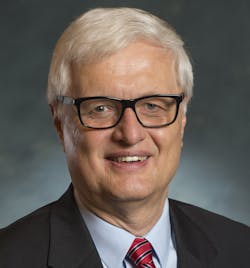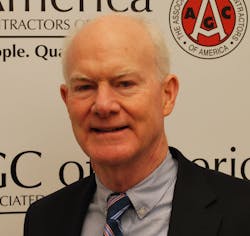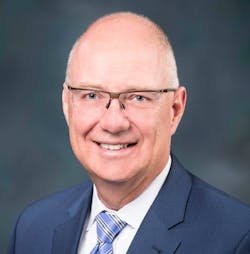2019 Industry Icons
Neil Pedersen, Executive Director, Transportation Research Board
THE AIM OF A LIFETIME
TRB’s executive director has no plans to quit now
by Brian W. Budzynski, Managing Editor
“When I was about eight years old, the Massachusetts Turnpike was being constructed not too far from our house.
“I became fascinated with the role new highways were playing in our world. I felt this from a very early age.”
It is wonderful—and wonderfully rare—to see the sort of fruition of one’s youthful interest that one sees in Neil Pedersen. One might suspect such lifelong devotion to come at a premium, but after speaking with Neil recently, I can assure you this is far from the case.
“Another of my formative experiences was learning how the church my mother belonged to in Brooklyn had been displaced by the approach for the Verrazano-Narrows Bridge. It split the neighborhood in half so that people who normally had only to walk a few blocks to visit friends now had a 3-mile detour. That really struck a nerve with me. As a result, I wrote my undergraduate thesis on the socioeconomic impacts of highway projects.”
This dual focus—the social and economic drivers and impacts of transportation development—has served Pedersen well over his more than 40 years in our industry. After earning both a B.S. in Civil Engineering and B.A. in Urban Studies from Bucknell University, Pedersen went on to a Master’s in Civil Engineering from Northwestern, where his concentration was in transportation planning. Thereafter followed seven years in the private sector, working as a transportation planning consultant. One of his clients during this time was the Maryland State Highway Administration (MSHA), which in 1982 appointed him deputy planning director.
This would be the beginning of a long tenure with the MSHA, during which time Pedersen would hold various titles. After 18 months, he was made Planning Director, a title he would hold for 16 years. Then it was on to Deputy Administrator for Planning, Engineering and Real Estate, and finally State Highway Administrator, a post he held until his retirement from MSHA in 2011.
During this time, Pedersen witnessed many changes, but one in particular stands out—one that fundamentally altered how project planning is done, even today.
“When I first started out in the mid 1970s, the approach was that planners and engineers would develop what they felt were the best plans, and then go and present them to the community. And then they’d wonder why the community almost always opposed what they proposed. We recognized that a new approach was needed. Too many projects were being held up due to community and political opposition. What we really needed to do was work with the community right from the beginning. Residents, businesses, the political establishment—the larger community, in other words. Basically anyone affected by the projects. It was really the beginning of what is now called context-sensitive solutions. It has been generally recognized as a necessity, especially in urban and suburban areas, if you’re going to get complex, large-scale projects through the planning and approval process.”
Pedersen also has been a multifarious committee member; among his appointments: Chair of the TRB Executive Committee in 2011, and five years as Vice Chair of AASHTO’s Standing Committee on Highways.
“My involvement with TRB and AASHTO allowed me to learn a lot about what was going on outside of Maryland, and what national policy issues were,” Pedersen said, “while also being able to bring that knowledge back to Maryland.”
After leaving MSHA, he was appointed Deputy Director of Implementation and Communication for SHRP 2. In 2015, he was appointed Executive Director of TRB, a role he has no plans to relinquish in the near future: “When I took on the job, I anticipated staying in it at least seven to 10 years, which would take me through TRB’s centennial in 2020-2021. My predecessor twice removed, Tom Deen, told me when I first accepted the position, ‘This is the best job in all of transportation. You get to work with the smartest people in transportation. You get to really grapple with current and future issues. You get to make recommendations to state and federal government that really make a difference in transportation policy.’ I enjoy going to work every day. Every day is a new issue we’re going to deal with. Why would I want to give up a job I am being fulfilled by, and feel allows me to make a difference?”
------------------
Brian Deery, Senior Director, AGC Highway and Transportation Division
MAKING AN IMPACT
AGC highways director has spent decades influencing transportation policy
by Tim Bruns, Associate Editor
By the time he finished his first few years of college, Brian Deery had little doubt that he wanted to play a part in the political process.
“As a kid growing up, oddly enough, I was always interested in what was happening in Washington. I always followed legislation, Capitol Hill, what presidents were doing.” He recalled a civics class teacher from eighth grade whose lessons contributed to shaping his interest in politics. “I remember him writing on the board how political parties came up with positions and how they had planks. And I thought that was really interesting.”
While he initially began his undergraduate studies at George Mason University in Fairfax, Va., with an undeclared major, Deery decided to chase a career in political science and government by his sophomore year. This worked well in his favor as the school’s proximity to Washington, D.C., enabled Deery to obtain internships in the nation’s capital. After finishing his time at George Mason, he went on to complete a Master’s in Public Administration at the American University in D.C.
Currently serving in the role of Senior Director of the Highway and Transportation Division, Deery has worked for most of his career with the Associated General Contractors (AGC) of America. This began over 40 years ago when he was hired as the assistant director in the Heavy Industrial Division. “When I was looking for a job, there were pretty much three choices,” Deery explained. “One, you could work for the federal government. Two, you could work on Capitol Hill in a congressional office. Or three, you could work for an association or one of the other interest groups that represent various industries before Congress and the government. And so I chose the latter. And I was fortunate to be hired by AGC.”
In his current position, Deery puts his passion for shaping public policy to good use. As senior director for Highway and Transportation at AGC, Deery oversees a range of legislative, regulatory and market issues which affect contractors in the highway, bridge, transit, railroad and airport runway construction sectors. His role demands he maintain an ongoing, collaborative relationship with a variety of federal transportation agencies and industry groups.
For his part, Deery works closely with AGC’s Congressional Relations Department, which seeks to educate members of Congress on the most pressing needs of the construction industry. “When Congress is looking at different issues, they tend to look at the big picture,” he explained. “And they don’t always see how it’s going to impact different industries. And so it’s important for us to be up there to explain the impact.”
When it comes to impacting law and policy in his career, Deery has had a hand in shaping all major transportation legislation that has made its way through Capitol Hill since TEA-21 in the late 1990s. He also has been instrumental in working with federal agencies to limit the impact of new regulations on the construction industry. An example of this was when proposals were created to place new emission requirements on diesel engines, which fuel many types of commonly used construction equipment. “They were going to put all these requirements that really would have required contractors to get rid of or sell their equipment at no value, and then buy new equipment,” Deery explained. “And for a lot of our contractors, that would have put them out of business.” To alleviate those concerns, Deery was able to work with the agencies involved to provide a way for contractors to receive grant funding to retrofit their existing equipment in order to meet the new standards for lower emissions.
When asked about current challenges that contractors face today, Deery considers the decline in workforce among the greatest concerns. “With the low unemployment rate in the country and with the growth in the construction market, contractors all over the country are facing a real shortage of workers,” he said. In addition to this, he recognizes the rise in new technology as something the industry has to keep up with, from the use of drones to the implementation of project management and estimating softwares.
Though he has no specific plans to retire in the near future, Deery acknowledges that he is likely coming to the end of his career, and he is looking forward to spending some time traveling internationally with his wife when that time comes. He also is eager to find ways he can volunteer his time during retirement. “Since I’ve spent all these years working for companies and people that build things, I’ve thought maybe Habitat for Humanity or something like that would be interesting for me to do—the hands-on stuff that I’ve been watching others do for all these years.”
For Deery, the most rewarding part of working for AGC has been getting to see the impact the projects built by the association’s members have had on the communities they serve. “We’ve had several big projects here in the Washington area that have made some major changes in congestion and backup,” he said, citing the George Washington Parkway and the Woodrow Wilson Bridge as examples. “And I think to myself: Wow that’s pretty amazing that you could come up with a solution that really does have an impact on the daily commutes of people and their ability to get around to places.”
------------------
Kirk Steudle, Senior Vice President, Econolite
ROCK ON
Former Michigan DOT director continues to embrace new technology
by Brian W. Budzynski, Managing Editor
When is retirement not retirement? When is it more akin to evolution?
In the case of Kirk Steudle, it is just so. This past October, after retiring from the Michigan DOT after more than three decades of service—which culminated in a tenure as DOT director that began in 2006—Steudle continued to serve the world of transportation as Senior Vice President for ITS for traffic management firm Econolite. Such an evolution will hardly come as a surprise to those familiar with Steudle and his accomplishments. In his exiting statement to MDOT colleagues, Steudle commented that it had been “especially rewarding … to share my commitment and belief in the intrinsic value of public service.”
Kirk Steudle’s interest in the world of transportation began not with the technology advancements he is today inextricably associated with, but with the evergreen stuff: roads and bridges.
“I was born and raised in a small town in Michigan,” Steudle recalled. “Back in high school I was thinking about architecture, but realized civil engineering really fit me better. The chance to be outside, constructing things that impact peoples’ lives every single day—that was really appealing to me. I wanted to work in the public sector, to be the owner of the transportation system I worked on. That really propelled me toward the public service side.”
After graduating from Lawrence Technological University in Southfield, with a degree in construction engineering, and Michigan Technological University, Steudle took a job—“like most seniors, I was happy to take any job offer”—at the Michigan DOT, as an entry-level engineer.
“I figured, I’ll be here a few years and then I’ll move on to do something else,” Steudle said. “The next thing I knew, it was 31 years later.”
Most of Steudle’s career was, in fact, in roads and bridges—construction, contracts, project planning. Then in 2003, he was appointed Chief Deputy Director of MDOT, and soon thereafter rose to Director. And it was around this time that the advent of connected vehicles and the idea of “mobility” began to rear its head in the transportation landscape; Steudle was in the ideal place to take the reins and engage these new developments with immediacy.
“It was about how do you take this technology and fuse it into the existing transportation network, how do you make the transportation network more efficient,” Steudle remarked. “That was the goal, and this ultimately led me to the mobility space. If you’re not trying new things, you’re destined to stay in the 1970s forever.”
Despite Steudle’s advocacy for applying new technology and his belief in its immediate and long-term benefits, his approach was always marked with care and caution, a measuring stick that had certain immovable thresholds, notably the reduction of risk and the potential for serving as a successful exemplar for other agencies.
“I’m always reluctant to say, for example, ‘Oh this community tried this new technology, and it didn’t work,’ and using that as a reason not to try. At least they were trying to innovate and learn. At the same time, I do think there are instances where technology is not as good or successful as it is made out to be, and that ultimately hurts the agency that might adopt it and it hurts the credibility of new technology in general. To me, you do your homework, you eliminate as many risks as possible. This is tough for DOTs, because they can’t really afford for something to fail. They’re always looking for examples. Show me where this has been applied successfully already. Like e-construction. Paperless documentation. You’d say now well of course you do that. We all do. But MDOT instituted that back in 2012 when no one was doing it. There’s always that chance when you do something new that it isn’t going to work, of course. But we showed how it could be done correctly.”
As the years compounded so did his accomplishments. He oversaw Michigan’s first “bridge slide,” its first P3 for freeway lighting, and, most recently, the opening of MCity, a 32-acre facility dedicated to connected and autonomous vehicle research in 2015, as well as the 500-acre American Center for Mobility (which he served briefly as interim CEO/president) in 2018. He served on the board of AASHTO since 2006, and in 2011-2012 was its president. In 2014, he was chair of the Transportation Research Board executive committee, and also chaired the Strategic Highway Research Program (SHRP 2) committee. He also served on the ITS America board of directors as chair and participated in the group’s U.S. DOT advisory committee.
At present, Steudle remains not far away from the public sector that defined the lion’s share of his career. “Econolite’s in one-third of North America’s traffic signals. Talk about impacting peoples’ lives; we do it every day.”
If one needs further validation for Steudle’s status in the mobility world, look no further than former Michigan Gov. Rick Snyder, who had this to say on Steudle’s exit from MDOT: “Kirk has been … a leader in advanced vehicle technology that has helped make Michigan the mobility capital of the world. Kirk is known around the world as a mobility rock star—and that’s something all of Michigan should be proud of.”
-------------
We hope this becomes an annual offering, and for 2020 you, the reader, will be able to nominate who you think is an industry icon. Information on how to nominate is coming soon.



